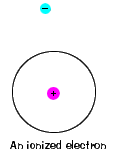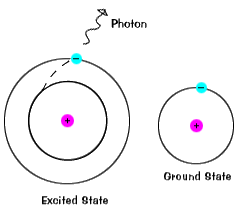What Happens When Electrons Return to Their Ground State
Atoms and Light Energy
The report of atoms and their characteristics overlap several different sciences. Chemists, Physicists, and Astronomers all must understand the microscopic calibration at which much of the Universe functions in order to see the "bigger flick".
Within the Atom
Simply like bricks are the edifice blocks of a dwelling, atoms are the building blocks of matter. Matter is anything that has mass and takes upward space (volume). All matter is made up of atoms. The atom has a nucleus, which contains particles of positive charge (protons) and particles of neutral accuse (neutrons). Surrounding the nucleus of an atom are shells of electrons - small negatively charged particles. These shells are actually dissimilar energy levels and within the energy levels, the electrons orbit the nucleus of the cantlet.
 | The ground land of an electron, the energy level information technology normally occupies, is the land of lowest free energy for that electron. |
| There is as well a maximum free energy that each electron tin have and still exist part of its atom. Beyond that energy, the electron is no longer bound to the nucleus of the atom and information technology is considered to be ionized. |  |
 | When an electron temporarily occupies an energy state greater than its footing state, it is in an excited state. An electron can go excited if information technology is given extra energy, such as if it absorbs a photon, or packet of light, or collides with a nearby atom or particle. |
Light Energy
Each orbital has a specific energy associated with information technology. For an electron to exist boosted to an orbital with a college free energy, information technology must overcome the difference in energy betwixt the orbital it is in, and the orbital to which information technology is going. This means that it must blot a photon that contains precisely that amount of free energy, or take exactly that amount of energy from some other particle in a standoff.
The illustrations on this page are simplified versions of real atoms, of course. Real atoms, fifty-fifty a relatively simple ones like hydrogen, have many different orbitals, and so there are many possible energies with unlike initial and final states. When an atom is in an excited state, the electron tin driblet all the mode to the ground state in one go, or terminate on the way in an intermediate level.
 | Electrons do non stay in excited states for very long - they soon render to their footing states, emitting a photon with the aforementioned energy as the one that was absorbed. |
Identifying Individual Types of Atoms
Transitions among the various orbitals are unique for each element considering the free energy levels are uniquely determined past the protons and neutrons in the nucleus. Nosotros know that different elements have different numbers of protons and neutrons in their nuclei. When the electrons of a certain cantlet return to lower orbitals from excited states, the photons they emit have energies that are feature of that kind of atom. This gives each element a unique fingerprint, making it possible to place the elements present in a container of gas, or even a star.
Nosotros can apply tools similar the periodic table of elements to figure out exactly how many protons, and thus electrons, an cantlet has. First of all, we know that for an atom to have a neutral charge, it must accept the aforementioned number of protons and electrons. If an cantlet loses or gains electrons, it becomes ionized, or charged. The periodic table will give us the atomic number of an element. The atomic number tells us how many protons an atom has. For example, hydrogen has an atomic number of one - which ways it has one proton, and thus i electron - and actually has no neutrons.
For the Educatee
Based on the previous description of the atom, draw a model of the hydrogen atom. The "standard" model of an atom is known as the Bohr model.Unlike forms of the same element that differ just by the number of neutrons in their nucleus are called isotopes. Most elements have more than one naturally occurring isotope. Many more than isotopes have been produced in nuclear reactors and scientific laboratories. Isotopes normally aren't very stable, and they tend to undergo radioactive decay until something that is more stable is formed. You may exist familiar with the element uranium - it has several unstable isotopes, U-235 existence i of the most normally known. The 235 means that this class of uranium has 235 neutrons and protons combined. If we looked upward uranium's atomic number, and substracted that from 235, we could calculate the number of neutrons that isotope has.
Here'south another instance - carbon usually occurs in the grade of C-12 (carbon-12) , that is, half dozen protons and 6 neutrons, though one isotope is C-13, with 6 protons and vii neutrons.
For the Educatee
Utilize the periodic table and the names of the elements given below to figure out how many protons, neutrons and electrons they have. Draw a model of an cantlet of the following element: silicon-28, magnesium-24, sulphur-32, oxygen-16, and helium-4.For the Educatee
Using the text, define the post-obit terms: free energy levels, absorption, emission, excited land, ground land, ionization, atom, element, diminutive mass, atomic number, isotope.A Optional Note on the Quantum Mechanical Nature of Atoms
While the Bohr atom described higher up is a dainty fashion to learn near the structure of atoms, it is not the most accurate way to model them.
Although each orbital does take a precise free energy, the electron is now envisioned as existence smeared out in an "electron cloud" surrounding the nucleus. It is common to speak of the mean distance to the cloud equally the radius of the electron's orbit. So just call back, nosotros'll keep the words "orbit" and "orbital", though we are now using them to describe not a flat orbital plane, but a region where an electron has a probability of being.
Electrons are kept near the nucleus past the electric attraction betwixt the nucleus and the electrons. Kept at that place in the aforementioned way that the nine planets stay near the Sun instead of roaming the galaxy. Unlike the solar system, where all the planets' orbits are on the same plane, electrons orbits are more three-dimensional. Each energy level on an cantlet has a dissimilar shape. There are mathematical equations which will tell yous the probability of the electron'southward location inside that orbit.
Allow's consider the hydrogen atom, which we already drew a Bohr model of.
 Likely locations of the electron in the ground state of the Hydrogen atom. | What you're looking at in these pictures are graphs of the probability of the electron's location. The nucleus is at the center of each of these graphs, and where the graph is lightest is where the electron is most probable to lie. What you run into here is sort of a cross department. That is, you accept to imagine the picture rotated effectually the vertical axis. So the region inhabited by this electron looks like a disk, just it should actually exist a sphere. This graph is for an electron in its lowest possible energy state, or "ground state." |
| To the right is an excited land of hydrogen. Notice that at the heart, where the nucleus is, the movie is dark, indicating that the electron is unlikely to be there. The two light regions, where the electron is most likely to be found, are actually simply i region. Remember, you lot have to mentally rotate this effectually a vertical axis, and so that in three dimensions the light region is really doughnut shaped. |  Likely locations of the electron in an excited state of Hydrogen. |
The text and images in this section were adjusted from Dave Slaven's folio on The Atom (see References beneath).
Reference URLs:
The Cantlet
http://webs.morningside.edu/slaven/Physics/atom/
Spectra
http://www.colorado.edu/physics/PhysicsInitiative/Physics2000/quantumzone/
The Periodic Tabular array
http://www.webelements.com/
Dorsum to the Main Spectra Unit of measurement Menu
Source: https://imagine.gsfc.nasa.gov/educators/lessons/xray_spectra/background-atoms.html
0 Response to "What Happens When Electrons Return to Their Ground State"
Post a Comment